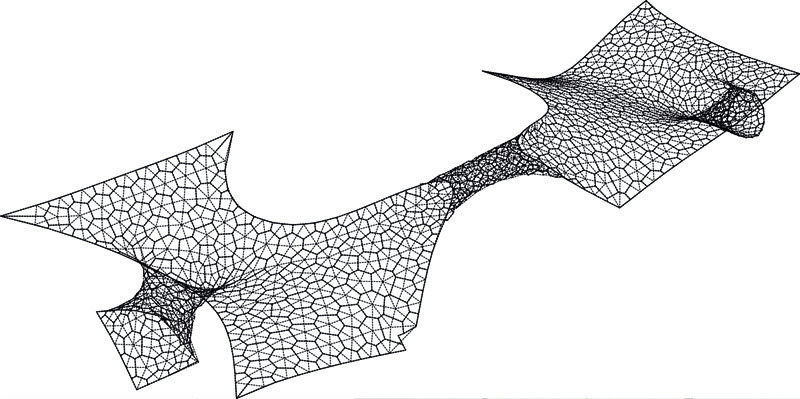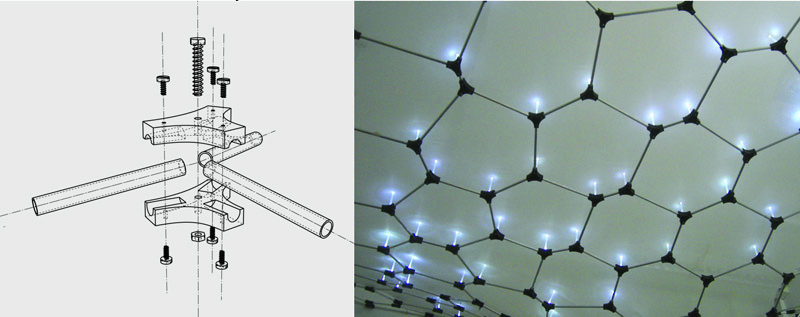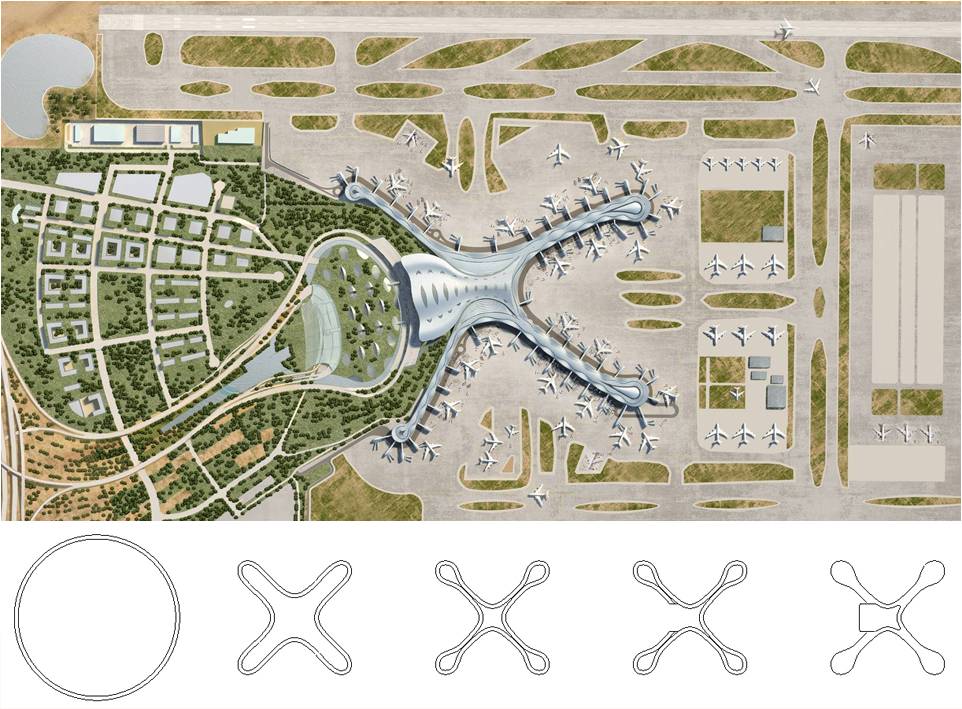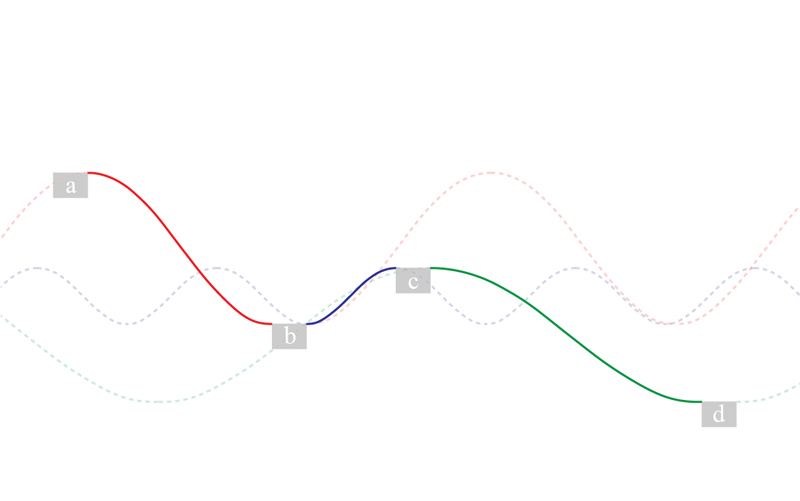Das Generative und das Synthetische
|
von Mirco Becker Das Original dieses Textes wurde in Modulor 02/2010 veröffentlicht. Die Entwicklung algorithmischen Denkens kann seit dem Altertum an der Geschichte der Nachrichtenverschlüsselung betrachtet werden. Dass diese Kulturtechnik jedoch erheblich vielseitiger ist, als Schriften zu kodieren, zeigt die fortschreitende Digitalisierung zahlreicher Lebensbereiche – die Nutzung von Mikroprozessoren für komplexe Abläufe, die in riesigen Datenbanken gespeicherten Informationen sowie die medialen und kommunikativen Veränderungen, an denen wir direkt teilhaben. Es existieren zwei Ansätze, bei denen das Digitale zu neuen Formen findet. Zum einen die Umwandlung vorhandener analoger Medien in digitale Formate wie Text, Ton und Bild. Zum anderen in der Schaffung neuer Kommunikationsträger, die erst durch die Digitalisierung überhaupt ermöglicht werden. — Two examples will demonstrate how these two methods change architecture, its creation and perception. The spatial installation Radiolara Project by Christian Troche is in every aspect true to the inherent logic of the digital. It involves all aspect form design to fabrication to construction and finally operation. The second, the design for the new Terminal of the Abu Dhabi Airport by KPF, demonstrates how digital means allows the synthesis of complex relations in a comprehensive and practical design environment. Closely connected to digital thinking is the notion of algorithmic complexity (Kolmogorov complexity). It is a measure for the degree of structure in a dataset, i.e. to specify the distribution of points in 3d space. A set of 100 points with random distribution have to be determined by XYZ coordinates thus leading to 300 entries in a table in order to be fully described. 100 points with equal distance along an axis of a Cartesian coordinate system can be expressed in a compact formula stating the XYZ coordinates of the first point, the modulus – equal distance, and the total number, thus only requiring 5 entries in a table. This degree of structure is not only of practical use but has aesthetic aspects too. We seemed to have developed a human condition to relate to order and patterns. In the biological as well as in physical phenomenology we discover patterns, which could be described by algorithmically. They manifest themselves in various degree of order as in snowflakes, inflorescences, fur patterns, or dunes formations. Digital design always deals with the description of order. Either these orders are given algorithmically or one has to find the next best algorithm to match the desired result. The Radiolaria Project is based on the patterned skeleton of radiolaria organisms, the design for the Abu Dhabi Airport looks out for algorithmic methods to capture design intentions and project constraints. Radiolaria Project – Emergent Order The Radiolaria Project by Christian Troche was developed, as part of his dissertation thesis. It is a piece of design research that covers the continuous nature of the digital. It employs methods form physics, biology and mathematics for form generation.
The design surfaces are created as minimal surfaces, only by defining their edge conditions. Minimal surfaces behave like soap film, spanning in an optimal fashion between edges or geometrically speaking the two principal curvatures cancel each other out in every single point resulting zero mean curvature. Frei Otto (Munich Olympic Stadium) discovered their properties for architectural applications by physical models in the 1960s. Only recently these methods are available computationally. This is not necessarily down to the algorithms which are know quite a while but mainly to the available computing power to simulate in real-time on personal computers, thus allowing a design dialogue and constant optimization of the result.
The main objective of the research was to find a system for structuring free form surfaces by linear members and 3-sided nodes. An algorithm was developed which tiled the surface in hexagonal and pentagonal shapes. Such network was generated on the design surface guided by the local principal curvatures. The overall pattern emerged form these local properties. A parametric connection detail was developed which could be manufactured on a 3-axis CNC router. The three incoming members can each vary in two axes resulting in 6 degrees of freedom for each node, consequently each joint and member in the system could be unique. This extreme variation does not lead to an overall complication as the programmatic enumeration provides for precise identification of each member. Instead of standardising the elements the production process is standardized. The paradigm shifts form a modular system to morphological system. This is similar to the leaves of a tree, all having the same predisposition but forming differently by responding to location, season, and orientation. The joints were manufactured from their inherent parametric definition directly off the design dataset. The length of each member was plotter along with its ID to a spreadsheet and cut to size. The erection was done without plan or instructions, as it was only a matter of connecting pieces according to the labelling. The overall form shaped up effortlessly simply by connecting all pieces. In a last step an LED was placed in each joint and all wired to a microprocessor. This created a visual play of light. Again, only the enumeration of the LEDs allowed the choreography of animated light patterns. Abu Dhabi Airport – Finding Order KPF won the international competition for the extension of the Abu Dhabi Airport in 2006. The design is not only convincing in how it resolves the functional and formal brief but mainly by proposing a process which integrates the different criteria algorithmically and putting them into computable dependencies. This new combination of design flexibility and control is the core of the process and makes the project unique. It allowed not only responding to all aspects during the design phase but also simulating scenarios which where outside the initial brief. The ambition to become the main airport hub at the gulf lead to the extension of the existing airport in Abu Dhabi by building a second runway and planning a new terminal with 46 gates, all under one roof. The X topology is a direct result of the number and types of gates of the projected fleet mix. The distortion of the ideal X figure negotiates the maximum key-length for planes to park, minimal walking distance, optimal area efficiency, and connection to the existing infrastructure. The parametric model was build by implementing a constraint solver that solved for geometric dependencies of points, lines, arcs and all their parameters. At each instance all constraints were satisfied and a list of reporting metrics generated. The art of setting up these models lies in balancing constraints and freedom to solve for a solution and future optimization. The building envelope is defined by 10 sections, which are blended by a periodic smoothing function. Only the position and the path along the plan outline of the building are defined. From this setup an infinitesimal number of steps between defined sections can be calculated. These dependencies allow controlling a rather large and articulate overall form with ease and precision. Both methods of working provide for a dialogue where a system is created that allows for control and change. The interplay of dependencies creates at every moment in time a coherent result. The designer’s interaction with the result is not a direct one, it is mediated by the system and only experimentation will enlighten him on how to steer towards a desired outcome. The Radiolaria Project is more radical in being solely based on algorithmic principles from the bottom up. The Abu Dhabi Airport is about the search for matching algorithms that suit the performative and formal desires and negotiate the balance between different criteria. As different as these to methods are they both employ the same principles. This does not lead to a new artificiality. Both projects demonstrate that the digital is developed enough today and used a Lingua Franca so synthetic and generative aspects equally contribute to shape our environment. We are just starting to see the potential and especially the search for specific algorithms demonstrates that the digital is an independent medium as defined by McLuhan. At the moment we are witnessing a series of buildings that are governed by a new sense of the natural, which is not necessarily based on form or aesthetics but generated form relations to the environment, which have been already established in the design generation process, like shown in the two examples – mainly by algorithm means. This method of design-thinking is based on processes and systems and will help to find answerers which are addressing complex systems much better than all mechanistic and hierarchical approaches which have dominated design, engineering and construction in the past. The issue of Modular was geuestedited by Rafael Schmidt Radiolaria Project by Christian Troche Abu Dhabi Airport by KPF |




